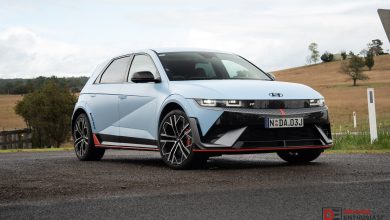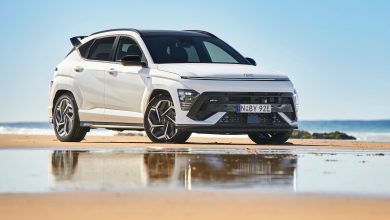Hyundai’s second-generation Kona Electric arrives with futuristic styling, more tech, and improved practicality, aiming to cement its place as one of the most versatile small EVs on the market.
The Standard Range version tested here sits at the entry point of the lineup, equipped with a smaller battery, lower outputs, and, most importantly, a more attainable price. Though, ‘attainable’ is relative in today’s EV market.
After a week behind the wheel, it’s clear the Kona has plenty to offer, but also a few quirks and compromises worth noting. Here’s how it stacks up in a top five pros and cons breakdown, in our opinion and in no particular order.

2025 Hyundai Kona Electric Standard Range: Pros
1. Among the most spacious and practical in its class
For a small SUV, the latest Kona punches well above its weight when it comes to packaging. The cabin feels noticeably more open than many rivals thanks to a slightly wider (+25mm) and longer (+150mm) body than the predecessor, and a flat floor. Rear seat space is generous for the class, with enough leg and headroom for adults to travel comfortably – not always a given in the segment.
The boot measures 407 litres, which is already competitive, and there’s a handy 27-litre front boot under the bonnet for storing charging cables or smaller items you don’t want in the main cargo area. Combined, that’s about the same amount of space as many medium-size SUVs.

2. Decent real-world range
The 48.6kWh battery in the Standard Range version offers up to 370km (WLTP), which should be enough for most daily commutes and weekend trips without having to plug in constantly. While longer-range EVs are obviously better for cross-country runs, this entry model still provides a decent buffer against range anxiety for urban and suburban use.
With the efficiency benefits of the heat pump (more on that below), you can expect the Kona to maintain respectable range even in less-than-ideal conditions. During our test we easily achieved 300km from a full charge.
3. Built-in V2L capability
One tech highlight is the interior Vehicle-to-Load socket, which lets you power or charge devices using a regular Australian three-pin outlet. That means you can run a laptop, inflate an air bed, or even power small appliances straight from the car’s battery – great for camping or as a backup during a blackout.
Now obviously this can eat into the overall range if used heavily, and most EVs these days offer this technology, it is good to see it remain on the base model. Hyundai could have cut this function to save cost and push buyers into higher-spec variants. But it didn’t.

4. Standard heat pump system
All Kona Electric models come with a heat pump for climate control. This might sound minor, but for EVs it’s an important efficiency advantage. Rather than using a traditional resistive heater that eats into driving range, the heat pump captures and repurposes waste heat to warm the cabin. The result is a more consistent range in cold conditions.
5. Generously equipped base model
Even in its most affordable form, the Kona Electric doesn’t feel overly stripped-out. You get twin 12.3-inch screens for the cluster and multimedia, wireless phone charging, digital radio, over-the-air software updates, and a comprehensive safety suite.
The cabin presentation is modern and high-tech, and many features that other brands reserve for upper trims are here as standard. However, the basic cloth seats and uneventful 17-inch alloy wheels are a dead giveaway.

2025 Hyundai Kona Electric Standard Range: Cons
1. Pricey for what it is
The Standard Range starts from $54,000 before on-road costs. That’s steep for a small SUV, and about $20k more than the very capable Kona Hybrid. While EV running costs are lower and the tech package is solid, it’s still a big jump for buyers who might otherwise consider the hybrid or petrol versions. It also puts the Kona in the firing line of larger and more powerful EVs from emerging brands.
2. Safety tech can be overbearing
The Kona’s safety suite is extensive, but in practice, some systems can feel intrusive. Lane keeping and driver monitoring in particular were very frustrating during our test drive, and switching them off isn’t a one-button affair – there’s a big process to go through.
And worst this, Hyundai has made it so these systems will reactivate if it thinks you’re distracted. Even something as innocent as yawning can trigger a warning chime, provoking lane-keep and driving monitoring to turn back on automatically. It often feels like you’re constantly being micromanaged.

3. Sluggish for an EV
With 99kW and 255Nm, the Standard Range is underpowered by small SUV standards, and especially so for an EV. Weighing in at 1690kg, the power-to-weight ratio of 58.6kW:1000kg is about the same as one of the slower dual-cab diesel utes.
Many buyers have come to expect brisk, instant acceleration from electric vehicles, even entry variants. So this kind of makes it worse. Around town it’s fine and the power/torque, although comparatively low, is still instant. But when merging onto freeways or overtaking you notice the lack of punch compared to other EVs.

4. Some omissions for the price
Despite its healthy list of standard kit, a few features are conspicuously absent on the Standard Range. There’s no surround-view camera, which is a useful tool in city driving, and the audio system is a basic six-speaker setup. At over $54k before on-roads, buyers may expect these to be included without having to step up to the Premium model.
5. DC fast charging is capped at 100kW
Charging speeds of up to 100kW are fine for a small battery, and Hyundai claims a 10–80 per cent top-up in 45 minutes. But in 2025, many rivals – even in the budget space – are moving toward 150kW or higher.
While the smaller battery here means shorter charging sessions compared with the long range version (also 100kW cap), the speed limit does reduce flexibility on longer road trips where faster charging can make a big difference.

2025 Hyundai Kona Electric Standard Range: Specifications
Electrical: 48.6kWh lithium-ion
Output: 99kW / 255Nm
Gearbox: Single-speed reduction gear auto
Drive type: Front-wheel drive
Wheels: F & R: 17×7.0, 215/60
ANCAP: Four stars
Weight: 1690kg
Power-to-weight: 17.07:1 (kg:kW)
Official range (WLTP): 370km
Max charging AC/DC: 10.4kW/100kW
Starting price: $54,000

























